Spanish Civil War: Russians on both sides of the front
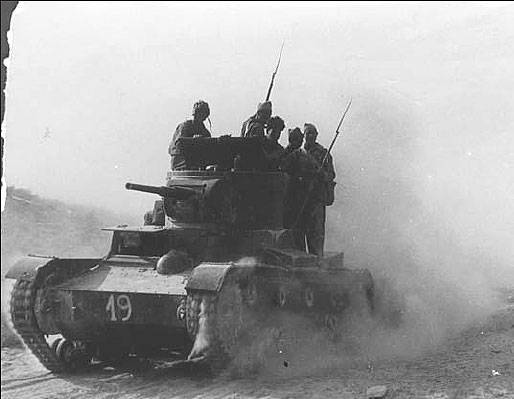
In 1931, the Republicans won elections in a number of major cities in Spain, they were in the city councils. This was the reason “to avoid a fratricidal war” to emigrate to King Alfonso XIII.
The newborn republic began its short life with speeches by left-wing forces and extreme left-wing forces: there were strikes, the seizure of factories, pogroms of churches, the killing of rich and clergymen. In early January 1933, the anarchist and syndicalist uprising began in Barcelona. The troops who remained loyal to the government, who supported the workers' squads, suppressed this performance, and called this event the “Barcelona Meat Grinder”. At least 700 people died in it, even more 8 thousands were injured. In the country, for more than three years, there was a real undeclared civil war between the revolutionary radicals and the right-wing opposition that had become strong by this time. In 1933, the Spanish phalanx was created. 10 April 1936, the Spanish parliament deprived President N. Alcala Zamora of the powers of the head of state. A month later, he was replaced by Spanish Prime Minister Manuel Asania, leader of the Left Republicans party. The head of the government was Santiago Casares Quiroga, who was close to Asane. In fact, the left received supreme power in the country, Asania and Casares Quiroga legalized the seizure of landlords by the peasants, and the demands of the striking workers reacted positively. The government pardoned all the prisoners, and a number of right-wing figures like General Ochoa, who led the suppression of the Asturian uprising, or the Spanish phalanx leader José Antonio Primo de Rivera, were arrested. As a result, the right began to prepare for an armed rebellion.
The spark that finally blasted the situation was the assassination of lawyer José Calvo Sotelo, the leader of the monarchists, the deputy of the Cortes, on 13 in July. He made a diatribe against the republican government in parliament. He was killed by state police officers who were also members of leftist organizations. Soon General A. Balmes, deputy head of the military commander's office, died in the Canary Islands under incomprehensible circumstances. Both of them were accused by supporters of President Asanya. This overwhelmed the patience of the right-wing oppositionists. Under the circumstances, the authorities in the country decide to seize the military in order to establish the dictatorship and save Spain from the so-called. "Red threat". The right-wing conspiracy was officially led by Sanhurho, who lived in Portugal, but the main organizer was General Emilio Mola, who was exiled by the Popular Front to the remote province of Navarre. Mole managed in a short time to coordinate the actions of a significant part of the Spanish officers, Spanish royalists (both carlists and alfonists), members of the Spanish phalanx and other opponents of the left government and left workers' organizations and movements. The rebellious generals managed to receive financial support from many large Spanish magnates, industrialists and farmers, such as Juan March and Luca de Tena, who suffered enormous losses after the victory of the left Popular Front, as well as the church provided material and moral support to the right forces.
In the evening of July 17 1936, garrisons rose against the republican government in Spanish Morocco, the military quickly established control over the Canary Islands, Spanish Sahara (now Western Sahara), Spanish Guinea (now Equatorial Guinea). Some time later, General Francisco Franco assumed command of the rebels. On the same day, July 17, on the outskirts of Madrid, Cuatro Caminos began to form five volunteer battalions of the Spanish Communist Party. Forces were distributed, and the country collapsed into the arms of the war, a long bloody confusion began.
Russians on both sides of the front
The Spanish Civil War attracted almost the whole of Western and not only peace. All had a reason to intervene or, with their "non-interference", support any side. The "white" of Spain was supported by monarchists, fascists, Nazis, and the "red" left forces from many countries. A part of the Russian emigration also intervened, their aspirations expressed by the participant of the war, General A.V. Fok, he wrote the following: "Those of us who will fight for national Spain, against the Third International, and also, in other words, against the Bolsheviks, will thereby fulfill their duty to white Russia." Although for example: the French authorities prevented the transfer of Russian into the army of General Franco. And the Guards Cossack Division in Yugoslavia wanted to fight on the side of the Francoists, but the Cossacks did not receive guarantees of material support for the families of the dead or disabled and did not take part in the war. But nevertheless, it is known about several dozens of Russian volunteers who made their way to Spain at their own risk and fought for Franco.
Of these, the 34 man died, including Major General A.V. Fock, and of the survivors, many were injured. During the battle in the Quinto de Ebro area, his unit was surrounded and almost completely destroyed. Having spent all the opportunities to resistance, A.V. Fock shot himself in order not to fall into the hands of the "red". In the same battle, captain Ya.T. died. Polukhin. He was wounded in the neck, he was taken to the local church for dressing and where he was buried - shelling destroyed her. Posthumously, they were awarded the highest military award of Spain - the collective laureate. At various times in the Spanish battles killed: Prince Laursov-Magalov, Z. Kompelsky, S. Tehli (V. Chizh), I. Bonch-Bruevich, N. Ivanov and others. Kutsenko, who was wounded at Teruel, was captured and tortured to death. Known as the sea pilot died, Senior Lieutenant V.M. Marchenko. 14 September 1937 Marchenko flew to the night bombing of the enemy’s airfield. After completing the mission, the aircraft of the senior lieutenant was attacked by several enemy fighters. In an air battle, Marchenko's plane was shot down, and the crew of the car (pilot, machine gunner and mechanic) jumped out with parachutes. Having landed safely, Marchenko began to go out to his positions, but on the way he ran into the Reds and was killed in a shootout. According to the Maritime Journal of those years, the body of Marchenko, at the request of pilots from the USSR, who took part in this air battle, was buried in the city cemetery.
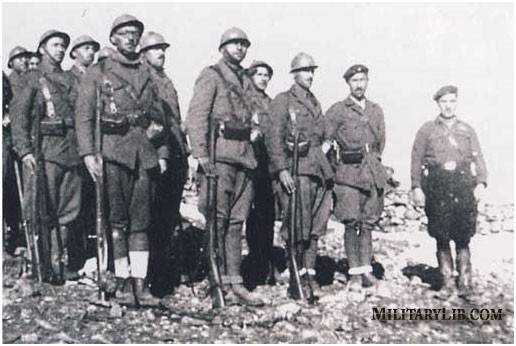
Russian detachment in the army of General Franco.
As for the enemy's air rival, V. M. Marchenko, then apparently, it was the captain I.T. Eremenko, he commanded a squadron of I-15, which operated near Zaragoza. Eremenko fought in the skies of Spain from May 1937 of the year to 6 of February of 1938 of the year and he was twice presented to the Order of the Red Banner and awarded the star of the Hero of the Soviet Union. And the Soviet pilot received his latest award for the battles near Zaragoza.
30 June 1939 of the year (by 1 in April of 1939, Franco controlled the whole country) Russian volunteers were officially fired from the ranks of the Spanish national army. All of them received the rank of sergeant (except for those who already had the rank of officer), Russian volunteers received a two-month leave with the same pay and the military awards of Spain - “Military Cross” and “Cross for military valor”. In addition, all Russian volunteers were able to become Spanish citizens, which many of them took advantage of.
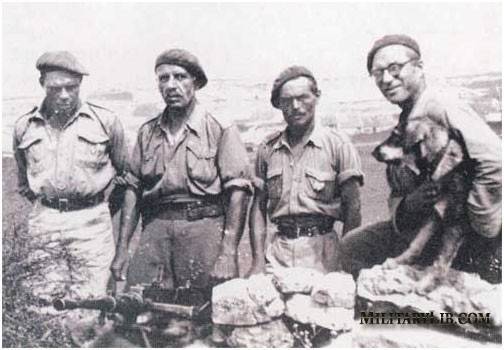
A group of Russian Kornilov officers from the Russian detachment of General Franco’s army. From left to right: V. Gurko, V. V. Boyarunas, M.A. Salnikov, A.P. Yaremchuk.
A significant number of immigrants from Russia fought on the side of the republican government - according to the data of the emigrants themselves, about 40 officers; according to Soviet sources - from several hundred to a thousand people. Russian volunteers fought in several units: in the Canadian battalion. Mackenzie Palino, Balkan Battalion. Dimitrov, battalion them. Dombrowski, the Franco-Belgian brigade (later 14-I Interbrigade) and others. Several Ukrainians fought in the battalion under the long name "Chapaev-battalion of twenty-one nationalities."
In many divisions of the republic, by virtue of their experience and skills, Russian emigrants occupied command positions. For example: the company commander in the battalion them. Dombrowski was a former lieutenant I.I. Ostapchenko, former Colonel of the White Army V.K. Glinoetsky (Colonel Heemens) commanded the artillery of the Aragon front, the commandant of the 14-Interbrigade headquarters was the former Petliura officer Captain Korenevsky. The son of the famous “Russian terrorist” B.V. was the captain of the republican army. Savinkova - Lev Savinkov.
It is interesting to note that the transfer to the Spanish front of several hundred Russian volunteers-internationalists from Czechoslovakia, Bulgaria, Yugoslavia, France, together with the Spaniards, were organized by Soviet intelligence agencies, which received personal authorization from I.V. Stalin on January 19 1937. And "Unions for returning to their homeland" were engaged in the primary selection of candidates, their testing, training and instruction. V.A. was an active participant in this movement for homecoming (in the USSR). Guchkov-Trail, daughter of the famous Octo-leader A.I. Guchkov, who was in the first part of the Provisional Government military and naval. In 1932, Guchkov-Trail began to cooperate with the OGPU authorities and in 1936, she was part of a special organization that recruited volunteers in Spain.
USSR intervention
Although it should be noted that Moscow did not immediately get into the Spanish war, the USSR had no special interests there — political, strategic, economic — there was not. They did not intend to fight on any side, this could cause serious international complications, and the USSR was accused of wanting to “kindle the fire of the world revolution”. Only under the pressure of the fact that the republican government supported all sorts of left-wing organizations, and among them the growth of the authority of the supporters of Trotsky, forced the USSR to intervene, and then not to full force.
Therefore, after hesitation and doubt, it was only in 29 of September that an action plan was approved for X (Spain), developed by the head of the foreign department of the NKVD, A. Slutsky. This plan provided for the establishment abroad of special companies for the purchase and shipment to Spain. weapons, equipment and other military equipment. Various Soviet people's commissariats and departments received instructions to organize military supplies directly from the Soviet Union. The question raised by Stalin and Voroshilov about sending regular units of the Red Army to the Iberian Peninsula was also discussed, but this is quite an adventurous proposal (which could lead to a serious conflict with Italy and Germany, and Paris with London would not be left aside) was rejected Soviet military leadership. They made an alternative decision - to send a staff of military advisers, military experts to Spain, to provide "international assistance" in the creation of a full-fledged regular republican army, its training, the development of operational plans, etc.
The system of the Soviet military advisory apparatus in republican Spain consisted of several levels: the Chief Military Adviser stood at the highest level — they were visited by Ya.K. Berzin (1936-1937), G.G. Stern (1937-1938) and KM Kachanov (1938-1939) .; at the next level, there were advisers in various services of the general staff of the republican army, so when General Rojo himself changed, five Soviet advisers changed, including KA Meretskov (vol. Petrovich volunteer). In the General Military Commissariat of the Republicans served two advisers - divisional commissars of the Red Army. The headquarters of the Republican Air Force changed nine Soviet advisers. The headquarters of the artillery and the headquarters of the Navy was visited by four advisers. Two advisers each were at the headquarters of the Republican Air Defense and during the military medical service. Another level consisted of Soviet advisers to the front commanders - 19 people passed this level.
At the same level, but only at the headquarters of various republican fronts, eight more advisers served, as well as Soviet commanders-instructors, advisers to Spanish commanders of divisions, regiments and other military units. Among them was A.I. Rodimtsev - later famous Colonel-General, distinguished himself in the Battle of Stalingrad. It is necessary to recall the group of Soviet weapons engineers who helped establish the Spanish military industry in major republican cities — Madrid, Valencia, Barcelona, Murcia, Sabadell, Sagunto, and Cartagena. Soviet engineers were included in the staff of Spanish factories that produced weapons and assembled fighters under Soviet licenses.
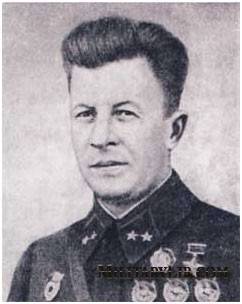
Military Advisor A.I. Rodimtsev.
At the fourth, basic level, consisted of military volunteers: pilots, tank crews, sailors, scouts, gunners, etc. those who directly participated in the hostilities.
The first to arrive on the Spanish front in September 1936 were the Soviet pilots, who soon took part in the air battles in the direction of Madrid as part of the 1-th international bomber squadron. October 27 1936 of the year 1 Squadron made its first combat mission to the airfield area in Talavera, 160 km from Madrid. In October of the same year, 30 speed bombers of the SB were brought to Spain from the USSR. Of these, a bomber group was formed in the 3-x squadrons. In addition, they created a fighter group (three squadrons on I-15 and three on I-16 and 10 combat units in each squadron) and an assault group (30 vehicles). By this time, the 300 of the Soviet falcons fought on this war.
Quite a lot of evidence of the heroic fulfillment of military duty by Soviet pilots in the sky of Spain has been preserved. S. Chernykh, a fighter pilot, first shot down a German Messerschmitt-109 in the sky of Spain. P. Putivko, the flight commander, made a ram in an air battle in the area of Madrid - he became the first stories Soviet aviation! Having received the Order of the Red Banner. Lieutenant E. Stepanov made the first ram in the history of Russian aviation, he sent his I-15 to the Italian aircraft Savoy. On October 15, 1937, according to the recollections of the military translator of the air squadron A. Gusev V. Alexandrovskaya, our pilots conducted a unique operation to destroy enemy aircraft at the Garapinillos airfield, near Zaragoza. It was attended by pilots of the fighter group under the command of E. Ptukhin (chief of staff F. Arzhanukhin) - in about half an hour the Stalinist falcons burned more than 40 Italian aircraft, warehouses, hangars with spare parts, ammunition, and fuel.
Distinguished in hostilities on the side of the Spanish Republicans and tankers from the Soviet Union. The Spanish armed forces had only two tank regiment, one of them (it was armed with old French Renault tanks from the end of the First World War) remained on the side of the Republicans. At the beginning, Soviet tankers served as teachers at a training center in Archena (Murcia province), but already on October 26, 1936, when a critical situation arose in Madrid, they were brought into a company of 15 tanks - the Spanish cadets became loaders. The company commander was the Soviet captain P. Arman, who later became a Hero of the Soviet Union. Later in the Republican army, they were able to create larger tank units. Soviet tankmen became the backbone of these. So, the Spanish Republican 1st Armored Brigade, which was actually created on the basis of the brigade (T-26 tanks) of the Belarusian Military District, consisted of two-thirds of Soviet military experts. The brigade commander was brigade commander D.G. Pavlov (future Hero of the Soviet Union), and the chief of staff - A. Shukhardin.
October 13 1937 was baptized in fire by the International Tank Regiment (based on BT-5 wheeled-tracked tanks). The regiment commander was Colonel S. Kondratiev (acted under the pseudonym of Antonio Llanos), the deputies of the regiment commander were Majors P. Fotchenkov and A. Winds (Valentin Rubio), the regimental chief was Major V. Kolnov. The commanders of the three tank companies were Soviet captains P. Sirotin, N. Shatrov and I. Gubanov. All the mechanics-drivers of the regiment's tanks were also Soviet military. Soviet volunteers were set to fight the most dangerous sectors of the front. Tank companies and platoons of the regiment, often without infantry, attacked the enemy, participated in street battles, fought in the difficult conditions of mountains and frost, for which this fast and lightly armored tank BT-5 was not intended.
For example: February 19 1937 of the year in one of the battles hit the tank of the junior commander V. Novikov with three direct hits. The loader died, and the driver was mortally wounded. Novikov himself was seriously wounded, did not let the enemy go for more than a day, firing from a wrecked car, and waited for the help of his comrades. 29 October 1936 of the year during the fight under Cesinja T-26 tank commander S. Osadchy and his driver I. Egorenko were able to make the first tank ram, destroyed the Italian Ansaldo tank. In March, our BT-1938 tank, commanded by Lieutenant A. Razgulyaev and a driver, was the first to ram a German machine gun tank PzKpfw I.
Some foreign researchers, such as the British scientist R. Carr, noted the high combat qualities of Soviet tankers in the book Spanish Tragedy and noted that "throughout the war Soviet tankers had superiority over German and Italian tankmen." And this, apparently, is true. Their high fighting qualities are confirmed by the fact that 21 to a Soviet tankman who fought in Spain was given the knowledge of the Hero of the Soviet Union. In addition to pilots and tankers, Soviet sailors (submariners, speedboats), artillerymen, military intelligence officers, technicians, engineers fought in the ranks of the Republicans.
In total, 772 Soviet pilots, 351 tank crew, 100 gunners, 77 sailors, 166 communications men (radio operators and cryptographers), 141 engineer and technician, 204 translator fought in Spain. Of these, more than two hundred people died. Many advisers and military experts who fought in the ranks of the republican army later became prominent Soviet commanders and military leaders, of whom 59 people were awarded the title Hero of the Soviet Union.
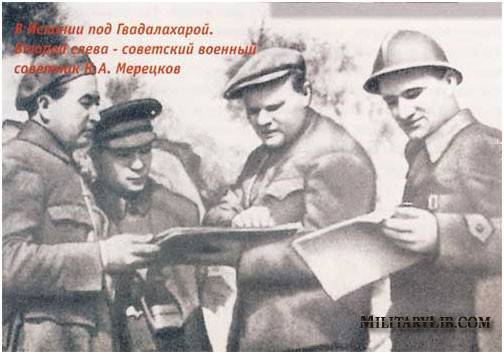
Thousands of citizens of Spain, Italy, Germany, Britain, France, who were on different sides of the barricades, became participants in this war. Some supported the nationalists, others, at the call of the Comintern and democratic organizations in the countries of Western Europe, became fighters of the Inter Brigades. This was an unprecedented event: thousands of people left their homes, families, became a gun and went to fight in a completely foreign country. What is "war" most of the recruits did not know. More than 35 thousand people became fighters of Interbrigades.
Fearlessness and professionalism distinguished Russian officers and children of white immigrants who fought on Franco's side. These qualities were famous and Soviet specialists. "White" and "Red" were not mercenaries. They fought for the idea. Soviet specialists believed that they were fighting fascism in the fields of Spain. For the whites (who abandoned their pecuniary wages), this war was a continuation of the civil war in Russia.
The film uses the diaries of the "white" volunteer and the memories of a prominent Soviet military specialist.
70 years have passed since the events described, and we have a unique opportunity to hear the true stories participants of events, devoid of ideological clichés.
Information